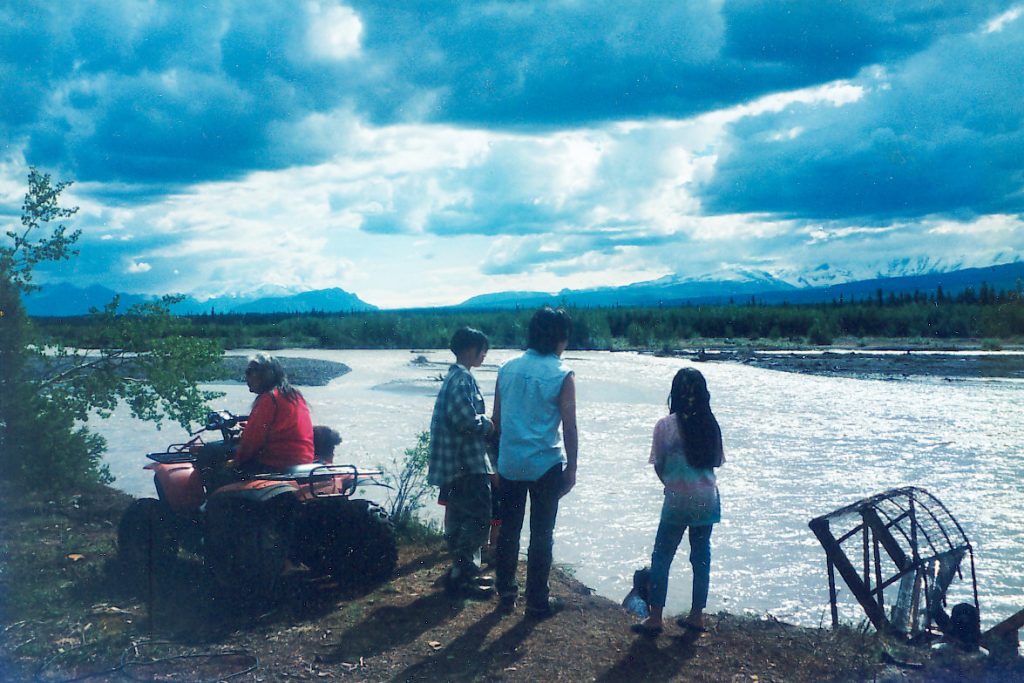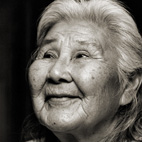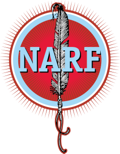Background:
Katie John is an Ahtna Athabaskan Indian and the daughter of the last chief of Batzulnetas. She was born in 1915 near the present day community of Slana and lived with her family at the Native Village of Batzulnetas from the time of her birth until 1937. Batzulnetas, which means “Roasted Salmon Place,” is a historic upper Ahtna village and fish camp and is located at the confluence of Tanada Creek and Copper River within what is now the Wrangell-St. Elias National Park.
Batzulnetas is a revered spot among the upper Ahtna who have fiercely defended this site for generations. Oral history and early written accounts tell of a massacre of Russians by the upper Ahtna at Batzulnetas around 1794, provoked by the abduction of women and the Russians driving out the men in the winter without adequate clothing. In 1885, nearly one hundred years later, Lt. Henry T. Allen arrived in Batzulnetas. With the Ahtna’s help, he became the first non-Native explorer to cross one of the passes from the Copper River to the Tanana River in Alaska’s Interior.
Batzulnetas was occupied by the upper Ahtna on a year-round basis until the mid-1940s when the villages were relocated to Mentasta so that their children could attend school. The residents of Mentasta are nearly all from, or have their roots in, Batzulnetas. A few Batzulnetas people moved to Dot Lake, Northway and other communities in the late 1930s or 40s, but continued to participate in the salmon fishery at Batzulnetas through family, friends, or by personally returning there to fish.

Katie’s father was Sanford Charlie and her mother was named Sarah. The family and other Batzulnetas village members relied on the salmon for much of their food. Salmon was dried, boiled, fried, and sometimes roasted. It provided sustenance throughout the year.
Alaska became a state in 1959 and assumed management of fish and game in 1960. In 1964, the State closed down the subsistence fishery at Batzulnetas and nearly all other traditional fishing sites in the upper Copper River and its tributaries under the guise of conservation, although there was no documentation of any need to do so. Closure of Batzulnetas to subsistence fishing ended its regular use as a fish camp. Nevertheless, Katie John and other residents of Mentasta village and former Batzulnetas returned regularly to visit grave sites and to experience the spiritual and cultural satisfaction derived from being present where they grew up and where their ancestors made their home. Traditional fishing continued on a sporadic basis, albeit subject to harassment by state officials. Aboriginal fishing practices were protected under the federal law of aboriginal title, although those protections were ignored by the state. The Alaska Native Claims Settlement Act of 1971 ended any theoretical or formal protection of aboriginal subsistence uses, but in 1980 the subsistence Title of the Alaska National Interest Lands Conservation Act (ANILCA) was passed. That federal law was intended to protect customary subsistence uses by Alaska Natives and other rural residents.
The Litigation
In 1984, Katie John and another Ahtna elder, Doris Charles, submitted a proposal requesting that the Alaska State Board of Fisheries open Batzulnetas to subsistence fishing. Their request was denied, despite the fact that downstream users were permitted to take hundreds of thousands of salmon for sport and commercial uses. The Native American Rights Funds filed suit in 1985 under Title VIII of ANILCA, to compel the State to re-open the historic Batzulnetas fishery. Although the State subsequently adopted regulations providing for a limited fishery, in 1990, the federal district court set aside this regulation as too restrictive. Before the State Board could react, the Alaska Supreme Court’s McDowell v. State decision struck down the state’s “rural” priority as unconstitutional under the stage constitution. As a result of the McDowell case, fish and game management in Alaska was divided into two distinct legal regimes – one governed by state law and the other by federal law.
Initially, the Alaska Supreme Court put its McDowell decision on hold. The Court did this so the State would have time to amend its Constitution, or otherwise bring its program into compliance with ANILCA. But the Legislature failed to act, and the Secretaries of Interior and Agriculture announced their intent to take over management of subsistence uses on federal public lands effective July 1, 1990.
Unfortunately, this was not helpful to Katie John. Initially the federal government adopted regulations which extended federal management to game on federal public lands but excluded fishing in all navigable waters. NARF then filed suit on behalf of Katie John in federal court against the Secretary of the Interior, claiming that the Secretary had unlawfully restricted construction of ANILCA’s reach, and that Congress intended to protect subsistence fishing activities in navigable waters as well as game on the public lands. Katie John argued that ANILCA’s public lands definition applies to navigable waters because of the federal government’s navigational servitude, or under the federal reserved water rights doctrine. When President Clinton took office, Katie John and Doris Charles petitioned the federal government to change their legal position in the litigation, which did occur on a limited basis late in the district court case.
A number of other subsistence cases were also filed in the wake of McDowell and Judge Holland of the federal District Court decided to manage them jointly. One such case was State v. Babbitt, a case brought by the State of Alaska alleging that the Secretary of the Interior lacked the authority to manage federal lands even when the State was out of compliance with ANILCA. Judge Holland segregated out the claims of the subsistence cases that were being jointly managed, and decided to address first what became known as the “who” and “where” issues. The “who” issue referred to the question of whether the federal government or the state possessed authority to manage federal public lands and waters, and the “where” issue referred to ANILCA’s definition of “public lands” and whether that phrase included some or all navigable waters.
In March 30, 1994, federal Judge Holland ruled that, the Secretary of the Interior, not the State of Alaska, possesses the statutory authority under ANILCA to regulate public lands and waters when the State is not in compliance with ANILCA. The court further held that “for purposes of Title VIII of ANILCA, the United States holds title to an interest in all navigable waters.” He concluded that ANILCA’s subsistence fishing priority extends to all navigable waters in Alaska based on the navigational servitude doctrine. That doctrine holds that the federal government has a superior interest in the regulation of navigable waters and need not pay compensation for takings when the United States alters a water way for the purpose of regulation commerce. This power is so great, Judge Holland reasoned, that it is akin to a property interest and vests title to navigable waters in the federal government. The government’s title interest brings navigable waters squarely within the definition of public lands. Judge Holland did not reject the reserved waters theory as a basis for finding a federal title interest in navigable waters, but declined to apply because in his view, it would be difficult to administer and was likely more limited in scope.
The State and federal governments appealed this decision to the Ninth Circuit Court of Appeals, in 1995, but the State elected to drop that part of the appeal that dealt with the ‘who’ issue, i.e., the State’s challenge to Secretarial authority to manage fish and game. The only issue that went up on appeal was the “where” issue which turned on the definition of “public lands”. The United States had changed its legal position at the very close of the district court litigation to agree with Katie John’s secondary legal theory premised on the federal reserved rights doctrine.
The Ninth Circuit issued a more limited ruling than the district court. It rejected the broad theory that was based on the federal government’s navigational servitude and instead upheld Katie John’s claim based on the reserved waters doctrine. That doctrine holds that whenever the federal government withdraws lands from the public domain for a federal purpose, it implicitly reserves water necessary to accomplish the purposes of the reservation. The government’s reserved water interest has been held to be a property interest which can be reduced to title. The court concluded that because it was clear that Congress intended to protect subsistence fishing when withdrawing public lands in Alaska, ANILCA’s subsistence priority applies only to those navigable waters in which the United States owns so called “reserved water rights,” or about 50% of Alaskas inland waters.
Shortly after the Ninth Circuit issued its ruling, the Alaska Supreme Court addressed the same issue in the case Totemoff v. State. In that case the state was prosecuting a Native subsistence hunter for taking a deer with the use of a spot light. He defended arguing that the state lacked jurisdiction to prosecute since the offense took place in federal waters. The Alaska Court rejected his claim and specifically took issue with the Katie John ruling stating that it was not bound by decisions of federal courts other than the United States Supreme Court on questions of federal law. The State of Alaska immediately filed the Totemoff decision with the Ninth Circuit, urging it to reconsider its decision. The Ninth Circuit refused.
The State of Alaska then asked the United States Supreme Court to review the case but the Court refused and the case was remanded to the agencies, the Departments of Interior and Agriculture, for the purpose of adopting regulations to identify which waters in Alaska were federally reserved and thus fell within ANILCA’s priority. That was in 1996. Shortly thereafter, Senator Ted Stevens adopted a moratorium against publication of a final rule. He justified the moratorium as necessary to give the Alaska Legislature more time in which to adopt language for a constitutional amendment. The moratorium would expire within a year if the Legislature failed to act. Senator Stevens and Congress subsequently included three more moratoria in annual federal appropriations bills in the hope that the legislature would act. When the forth moratoria expired without legislative action, the regulations became final.
In January 1999 the federal government issued its regulations identifying the waters in Alaska which fall under federal management. Before the regulations became effective, the State of Alaska petitioned the Ninth Circuit Court of Appeals to hear the case en banc. The Court agreed to have 11 judges hear the State’s en banc appeal.
After briefing and oral argument, on May 7, 2001, the Court of Appeals reaffirmed its earlier ruling and stated that “the [1995] judgment rendered by the prior panel and adopted by the district court should not be disturbed or altered by the en banc court.” Three of the eleven judges wrote separately to express their view that they would have adopted the district court’s more expansive reasoning and extended the priority for subsistence fisheries to all navigable waters. Three other judges dissented and expressed their view that Title VIII’s federal subsistence protections do not extend to any navigable waters at all.

Governor Knowles initially had 60 days to seek review by the United States Supreme Court, but he requested a 60 day extension until October 4, so he could give the matter further consideration. During this period the Alaska Native community organized the Fourth “We The People March” on August 21 and used the event to generate public support for the Katie John decision and to urge Governor Knowles to forego any appeal to the United States Supreme Court (see pictures below).
On the morning of August 27, 2001, Governor Knowles called Katie John by telephone to tell her that “The State of Alaska will not appeal the Katie John case to the United States Supreme Court.” He went on to tell her “that from this time on, the State will do everything we can to protect your subsistence rights.” A few weeks before making his decision, Governor Knowles had traveled to Batzulnetas to meet personally with Katie John, then-86 years old. As they sat near the stream where Katie John’s father and mother subsistence fished to feed their family, Governor Knowles heard a simple but compelling message. “Katie John said she only wanted to protect her right to subsistence so she can raise and provide for her family the best way she knows how, in the way taught by her parents and earlier generations.”
Upon his return from his meeting with Katie John, Governor Knowles revealed “I learned more that day than is written in all the boxes of legal briefs in this long lasting court battle. I understand the strength, care and values that subsistence gives to Katie John’s family, and to the thousands of similar families from Metlakatla to Bethel, from Norvik to Ft. Yukon to Barrow. I know – we all know – that what Katie John does is not wrong. It is right – right for her, right for the village.” He acknowledged that the State of Alaska has not been protecting the basic right of rural Alaskans to provide for themselves and their families.
Shortly after Governor Knowles announced his decision, a lawsuit was filed by the Alaska Constitutional Legal Defense Conservation Fund in state court on September 13, 2001, seeking to enjoin the governor to carry the appeal forward. The case was heard by Judge Reese who entered an order on September 25. In that order Judge Reese stated that:
[S]eparation of powers precludes this court from ordering the Governor to take a position pending litigation, i.e. further appeal of the Katie John decision. It would be an inappropriate exercise of the equitable power of the court under Civ. Rule 65 to assume such a mandatory injunction, this is not an extreme or exceptional case. Litigation and political remedies are available to plaintiffs, and they have suffered no injury, nor is injury imminent. The Katie John litigation decisions of the Governor on behalf of the State of Alaska are political by nature, and are not subject to control by this court.
That decision was appealed and affirmed by the Alaska Supreme Court on September 27, 2001.
On October 4, 2001, the date in which the Governor’s petition to file before the Supreme Court was otherwise due, the Alaska State Legislature filed a petition for leave to intervene and a petition for a writ of certiorari to the United States Supreme Court to carry the appeal forward. That petition was denied.
Litigation did not stop there. On January 5, 2005, the State of Alaska filed a lawsuit in the U.S. District Court for the District of Columbia challenging the final rule implementing the Katie John mandate which established that the United States must protect subsistence uses of fisheries in navigable waters where the United States possesses a reserved water right. In the State’s new lawsuit, the State challenged the Federal agencies’ implementation of the mandate by arguing that the reserved waters doctrine requires a quantification of waters necessary to fulfill specific purposes.
On January 7, 2005, Katie John, again represented by NARF, filed a counter lawsuit in the U.S. District Court for the District of Alaska challenging the Federal Agencies’ Secretaries’ final rule implementing the prior Katie John mandate as being too restrictive in its scope. Katie John’s complaint alleged that the Federal agencies should have included Alaska Native allotments as public lands and further that the federal government’s interest in water extends upstream and downstream from the Conservation Units established under the Alaska National Interest Lands Conservation Act. The State of Alaska intervened and challenged the regulations as illegally extending federal jurisdiction to state waters. The cases were consolidated again before Judge Holland.
On September 9, 2009, the Court entered an order upholding the agencies’ final rule as reasonable. While rejecting Katie John’s claim that the agency had a duty to identify all of its federally reserved water rights in upstream and downstream waters, the court stated that the agency could do so at some future time if necessary to fulfill the purposes of the reserve. The case was appealed to the U.S. Court of Appeals for the Ninth Circuit and argument took place on July 25, 2011.
In July 2013, a panel of the Ninth Circuit Court of Appeals affirmed the district court’s decisions upholding the 1999 Final Rules promulgated by the Secretary of the Interior and the Secretary of Agriculture to implement part of the Alaska National Interest Lands Conservation Act concerning subsistence fishing and hunting rights.
As threshold issues, the panel held that the Secretaries appropriately used notice-and-comment rulemaking, rather than adjudication, to identify whose waters are “public lands” for the purpose of determining the scope of the Act’s rural subsistence policy; and that in construing the term “public lands,” the Secretaries were entitled to “some deference.” The panel concluded that, in the 1999 Rules, the Secretaries applied Katie John I and the federal reserved water rights doctrine in a principled manner. The panel held that it was reasonable for the Secretaries to decide that the “public lands” subject to the Act’s rural subsistence priority included the waters within and adjacent to federal reservations; and reserved water rights for Alaska Native Settlement allotments were best determined on a case-by-case basis.
In March 2014, the U.S. Supreme Court denied the State’s petition ending twenty-seven years of litigation over subsistence rights in Alaska.
Katie John – Her Life and Legacy

On May 31, 2013, the Ahtna elder, matriarch and icon, passed away at the age of 97. Katie John was a long-time client of NARF, who represented her in federal court litigation for nearly thirty years. The Katie John litigation, more than any other subsistence case exemplifies the contentious battle waged between federal, tribal and state interests over jurisdiction of Alaska Native subsistence fishing rights.
With Katie John’s passing, her determination to protect and preserve the Alaska Native subsistence way of life will live on through her family, her children, her grandchildren and great-grandchildren. It has been an honor and privilege for all of us at NARF to have worked with such a great and wonderful matriarch. She is an inspiration to all Native peoples and to all people who believe in right and justice. Rest in peace, Katie, your legacy lives on.


